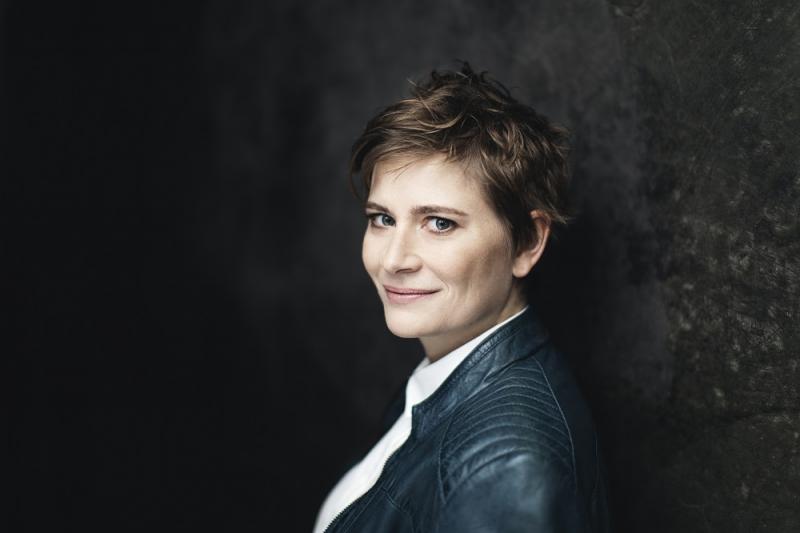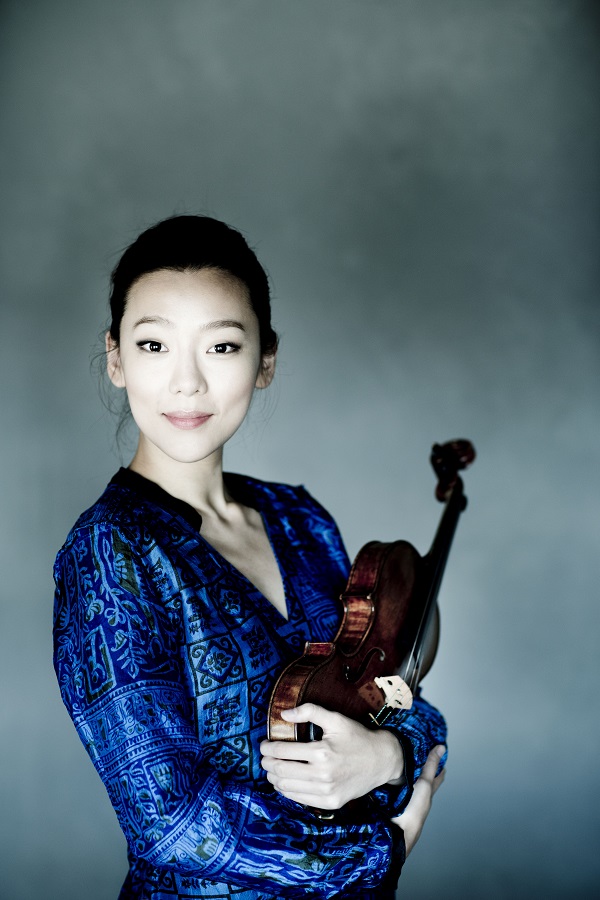Kang, National Symphony Orchestra, Bihlmaier, National Concert Hall, Dublin review - hats off, another top conductor | reviews, news & interviews
Kang, National Symphony Orchestra, Bihlmaier, National Concert Hall, Dublin review - hats off, another top conductor
Kang, National Symphony Orchestra, Bihlmaier, National Concert Hall, Dublin review - hats off, another top conductor
Interpretative excellence peaks in a phenomenal Schumann Second Symphony

Dublin is feted as the city of the word, peaking on Bloomsday, 16 June, in celebration of Ulysses’ centenary. Yet its concert and opera scene is broadening in brilliance. Had I known before yesterday that the vivacious Peter Whelan and his Irish Baroque Orchestra were performing Bach’s B minor Mass in Christ Church Cathedral, I might not have chosen to hear what until recently was called the RTÉ National Symphony Orchestra of Ireland – and wouldn’t have known what I’d missed.
As it happened I got almost the best of both worlds, admitted to the late afternoon rehearsal of the Bach, further wondering at the collective and individual excellences of the 10-strong, Belfast-born Sestina choir and leaving regretfully at the end of the Credo to walk to the lavishly restored National Concert Hall. The NSO, as it’s now called, has that dazzling animateur Jaime Martín as its chief conductor – already a good omen – but just as I hadn’t heard this fine orchestra live before, I also hadn’t made the acquaintance of the evening’s maestra, Anja Bihlmaier. With posts at the Hague’s Residentie Orchestra and the Lahti Symphony Orchestra, the German hasn’t come from nowhere, but the results were more spectacular than anticipated.
Even if they’d been merely good, I’d be forever grateful for knowing that Galina Ustvolskaya’s Sports Suite is a perfectly naughty curtain-raiser. Austere in her person and in the uncompromising musical style she regarded as truly her own, Ustvolskaya also wrote public Soviet works to pay the bills, later withdrawing most of them from circulation. This sort-of-10-movement divertissement (there are repetitions) starts like the “light” music of her mentor and would-be husband Shostakovich on steroids, all shrilling piccolo and rattling xylophone, and wraps several lurid but unashamedly populist dances around fragments that are as outrageously discordant and even menacing as the extremes of the older composer’s Fourth Symphony (still, in 1959, under wraps since being withdrawn from circulation at the end of 1936 before its first official performance). The NSO brass had a blatant ball with all this; so far, we saw Bihlmaier exercising exuberant but disciplined mastery.
 From the noisy to the super-refined: German-Korean violinist Clara-Jumi Kang (pictured left) gave a highly cultured performance of Mendelssohn’s Violin Concerto, beautifully partnered by Bihlmaier and the NSO wind especially. The handsome Victorian hall, newly upholstered, is a big space to fill, and it was probably more to do with the acoustics that the solo violin sound sometimes seemed to go upwards rather than outwards, But on this evidence I’d love to hear Kang in chamber music, and there was all the draw-them-in magic possible in her most soulful of encores, the Andante from Bach’s Second Violin Sonata - a clever choice, since its theme echoes the Andante of the concerto; Kang was too purposeful to allow either of them to be tainted by association with a certain well-known West End musical number.
From the noisy to the super-refined: German-Korean violinist Clara-Jumi Kang (pictured left) gave a highly cultured performance of Mendelssohn’s Violin Concerto, beautifully partnered by Bihlmaier and the NSO wind especially. The handsome Victorian hall, newly upholstered, is a big space to fill, and it was probably more to do with the acoustics that the solo violin sound sometimes seemed to go upwards rather than outwards, But on this evidence I’d love to hear Kang in chamber music, and there was all the draw-them-in magic possible in her most soulful of encores, the Andante from Bach’s Second Violin Sonata - a clever choice, since its theme echoes the Andante of the concerto; Kang was too purposeful to allow either of them to be tainted by association with a certain well-known West End musical number.
Mendelssohn, who conducted the first performance of Schumann’s Second Symphony in 1856, would surely have applauded Bihlmaier’s stunningly well-prepared, detailed and profoundly musical interpretation. Just how fine it was I can attest with favourable comparison to two great performances: Haitink’s with the Chamber Orchestra of Europe and John Eliot Gardiner’s with the London Symphony Orchestra. Unlike both, Bihlmaier went for the large-scale symphonic approach with a full complement of strings, all the more impressive when she flicked the switch to soft phrases or chords. Schumann’s style is such an elusive one to get right, but when it works, this comes across as one of the greatest symphonies ever.
Bihlmaier grasped the shape not just of each movement but of the whole, in which the almost manic exuberance of the first movement, past its flowing, chorale-like introduction, and the euphoric scherzo give way to the controlled melancholy of the Adagio espressivo and a finale which can’t quite shuck that off until the mid-point. Where Clara as the anchor to Schumann’s life creeps shyly out in his version of the lovely melody in Beethoven’s An die ferne Geliebte (To the Distant Beloved). The first thought was, what a magnificent work, rather than, what a remarkable performance.
Which it was, and though sparse in the big space – do the Irish get frightened off by an unfamiliar name on the programme? – the audience roared its approval. Proceedings were warmed by the fluent opening presentation of RTÉ lyric fm’s Paul Herriott, avoiding all the usual pitfalls (like I wrote up topm they're good with words, the Irish, and the programme notes were good, too). Not a bad first evening at all in a city where I’ll be spending much more time from now on.
The future of Arts Journalism
You can stop theartsdesk.com closing!
We urgently need financing to survive. Our fundraising drive has thus far raised £49,000 but we need to reach £100,000 or we will be forced to close. Please contribute here: https://gofund.me/c3f6033d
And if you can forward this information to anyone who might assist, we’d be grateful.

Subscribe to theartsdesk.com
Thank you for continuing to read our work on theartsdesk.com. For unlimited access to every article in its entirety, including our archive of more than 15,000 pieces, we're asking for £5 per month or £40 per year. We feel it's a very good deal, and hope you do too.
To take a subscription now simply click here.
And if you're looking for that extra gift for a friend or family member, why not treat them to a theartsdesk.com gift subscription?
more Classical music
 Echo Vocal Ensemble, Latto, Union Chapel review - eclectic choral programme garlanded with dance
Beautiful singing at the heart of an imaginative and stylistically varied concert
Echo Vocal Ensemble, Latto, Union Chapel review - eclectic choral programme garlanded with dance
Beautiful singing at the heart of an imaginative and stylistically varied concert
 Scott, Irish Baroque Orchestra, Whelan, RIAM, Dublin review - towards a Mozart masterpiece
Characteristic joy and enlightenment from this team, but a valveless horn brings problems
Scott, Irish Baroque Orchestra, Whelan, RIAM, Dublin review - towards a Mozart masterpiece
Characteristic joy and enlightenment from this team, but a valveless horn brings problems
 Classical CDs: Voice flutes, flugelhorns and froth
Baroque sonatas, English orchestral music and an emotionally-charged vocal recital
Classical CDs: Voice flutes, flugelhorns and froth
Baroque sonatas, English orchestral music and an emotionally-charged vocal recital
 Kanneh-Mason, Britten Sinfonia, Shave, Milton Court - a grin and a big beaming smile
A pair of striking contemporary pieces alongside two old favourites
Kanneh-Mason, Britten Sinfonia, Shave, Milton Court - a grin and a big beaming smile
A pair of striking contemporary pieces alongside two old favourites
 theartsdesk at the New Ross Piano Festival - Finghin Collins’ musical rainbow
From revelatory Bach played with astounding maturity by a 22 year old to four-hand jazz
theartsdesk at the New Ross Piano Festival - Finghin Collins’ musical rainbow
From revelatory Bach played with astounding maturity by a 22 year old to four-hand jazz
 First Person: Manchester Camerata's Head of Artistic Planning Clara Marshall Cawley on questioning the status quo
Five days of free events with all sorts of audiences around Manchester starts tomorrow
First Person: Manchester Camerata's Head of Artistic Planning Clara Marshall Cawley on questioning the status quo
Five days of free events with all sorts of audiences around Manchester starts tomorrow
 Goldscheider, Brother Tree Sound, Kings Place review - music of hope from a young composer
Unusual combination of horn, strings and electronics makes for some intriguing listening
Goldscheider, Brother Tree Sound, Kings Place review - music of hope from a young composer
Unusual combination of horn, strings and electronics makes for some intriguing listening
 theartsdesk Q&A: composer Donghoon Shin on his new concerto for pianist Seong-Jin Cho
Classical music makes its debut at London's K-Music Festival
theartsdesk Q&A: composer Donghoon Shin on his new concerto for pianist Seong-Jin Cho
Classical music makes its debut at London's K-Music Festival
 Helleur-Simcock, Hallé, Wong, Bridgewater Hall, Manchester review - moving lyricism in Elgar’s concerto
Season opener brings lyrical beauty, crisp confidence and a proper Romantic wallow
Helleur-Simcock, Hallé, Wong, Bridgewater Hall, Manchester review - moving lyricism in Elgar’s concerto
Season opener brings lyrical beauty, crisp confidence and a proper Romantic wallow
 Kohout, Spence, Braun, Manchester Camerata, Huth, RNCM, Manchester review - joy, insight, imagination and unanimity
Celebration of the past with stars of the future at the Royal Northern College
Kohout, Spence, Braun, Manchester Camerata, Huth, RNCM, Manchester review - joy, insight, imagination and unanimity
Celebration of the past with stars of the future at the Royal Northern College

Add comment